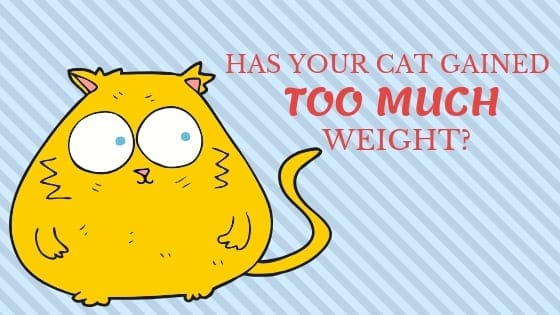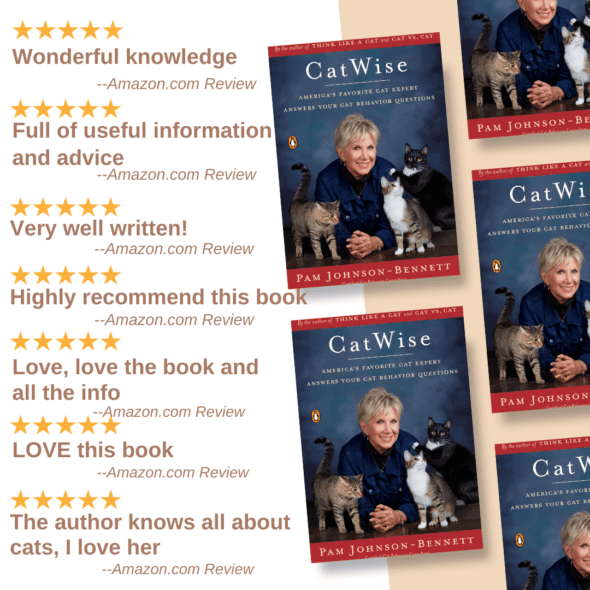
Do you think your cat is eating more than they should?
A Visit to the Veterinarian is Needed
A trip to the veterinarian is the first step toward determining if your cat has packed on too many pounds. In addition to weighing your cat, the veterinarian will do a physical once-over and run some diagnostic tests to find out if there is an underlying medical reason for the weight gain. Consulting your veterinarian is most important when you’re considering putting your cat on a diet or if you feel he isn’t the weight you think he should be.
Certain cats have particular body types and it’s important to know that before you decide that your cat is or isn’t at ideal weight. The body type of a cat such as a Persian will in no way resemble the slender body type of a Siamese. If you’re unsure, again, consult your veterinarian.
Have You Looked at Your Cat Recently?
A general way to get an idea of whether your cat has gained too much weight is to stand over him and look down. Do the sides bulge out? Can you see any kind of an indentation above the hips? In general, the average cat should carry a little fat over the rib cage. If you have a shorthaired cat, you should be able to detect a slight indentation above the hips.
Now place your hands on either side of your cat. If you firmly stroke your cat’s sides can you feel the ribs? With firm stroking you should be able to. If you can actually SEE the ribs then your cat is underweight. If the only way you can feel your cats ribs is by applying very firm pressure then kitty is likely overweight.
When stroking your cat, if you can’t feel the ribs at all, even with very firm pressure, or you feel fat pads along the backbone, then your cat is not just fat, but obese.
Does your cat’s belly hang down to the ground? After spay surgery it’s normal for a cat to lose some muscle down on the underside but if there’s lots of fat hanging down there, then she’s overweight. Keep in mind that cats do have a primordial pouch that hangs like a little loose skin on the underside. The primordial pouch is normal and is actually helpful to the cat. The abdomen is a very vulnerable area because injury can cause severe damage to the delicate organs located there. Having that loose skin provides extra protection during a fight. The pouch also helps the cat stretch out completely when in full stride. Cats are extremely flexible and the primordial pouch helps with extension. If you’re unsure whether the flabby skin hanging on your cat’s underside is the normal primordial pouch or too much fat, ask your veterinarian.
The Dangers of Being Overweight
If a cat gets too overweight it becomes difficult to engage in normal daily personal hygiene. Some overweight cats can no longer reach around to keep the anal area clean. Lift your cat’s tail up and see if the hindquarters are being neglected because he can’t access the area? Not only is this situation unhealthy, it’s very stressful for the cat. He depends on being able to groom and if he can no longer reach that area of the body, it can be stressful.
Cats who are overweight are more prone to heart disease, diabetes, arthritis, and other medical conditions. Ironically, some cat parents actually don’t even know what their cats’ ideal weights should be and are shocked when told their cats look overweight.
If you’re in doubt about whether your cat is too fat or are unsure about how much you should be feeding, consult your veterinarian. Your veterinarian will be able to advise you on the proper amount to feed based on age, health, body type, and activity level.
Establish a Safe Plan
If your veterinarian advises you to put your cat on a diet, you will be given instructions on how to do that safely. Cats can’t go on drastic diets because it can lead to a serious liver condition known as hepatic lipidosis. You must gradually restrict calories. Your cat didn’t get overweight quickly so the weight loss program must be gradual as well. His health depends on it.
In addition to being on an appropriate and safe nutritional plan, your cat also needs exercise. Customize the activity based on his health, mobility, and age. Even the smallest amount of daily exercise through playtime will be beneficial. Don’t exhaust your overweight cat to where he’s panting, but instead, create a fun playtime schedule that will be comfortable and something he will look forward to doing.
Need More Information?
For more information on cat behavior and training, refer to the best-selling books by Pam Johnson-Bennett. Pam’s books are available at bookstores and online. We’ve included Amazon links here on our website.
If you have a question regarding your cat’s health, please contact your veterinarian. This article is not intended as a replacement for your cat’s veterinary care. This article is for information purposes only and not offering medical advice. If you’re concerned about your cat’s weight or health, consult your veterinarian. Don’t put your cat on a diet without the guidance of your veterinarian.
 Problem Solving & Advice by Pam Johnson-Bennett Cat Behavior Expert & Best-selling Author
Problem Solving & Advice by Pam Johnson-Bennett Cat Behavior Expert & Best-selling Author




